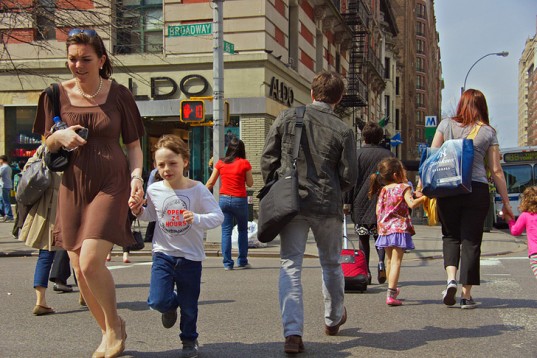In the spring Toronto experienced a horrifying event when a driver took a large vehicle up on the sidewalk in North York and deliberately killed ten people, wounding many others. It is an unspeakable tragedy and loss of life.
Out of that horror has come a renewed call for defending urban space, making it safer for pedestrians, hardening these potential “targets” to stop this from happening ever again. Price Tags has previously written about the 1,500 safety bollards being installed in New York City at a cost of 50 million dollars to protect pedestrians.
As the Globe and Mail’s Alex Bozikovic discusses it may be impossible to barricade and place concrete planters on every major street and pedestrian gathering place, but “we can do something to honour the other innocents who die in Toronto at a rate of one a week: change our roads.”
Mr. Bozikovic states: “We know exactly what to do. Very simply, fast-moving roads kill people; slowing down traffic saves lives. And we can accomplish that with design, if as a society we care enough.”
Last month I spoke on CBC Radio with Karen Reid Sidhu from Surrey Crime Prevention about the fact that car crashes are a major cause of death and injury in British Columbia. It has become such a concern that the former Provincial Medical Health Officer, Dr. Perry Kendall wrote a report about it: “Where the Rubber Meets the Road”.
Price Tags has written about the fact that over 45 per cent of all injuries in road crashes occur to vulnerable road users (those not encased in a steel shell). In terms of deaths for vulnerable road users, that has increased from 31.7 per cent of road fatalities in 2009 to 34.9 per cent of road deaths in 2011.
The figure is going up, not down, and communities have to say they have had enough. In a place where the health system is burdened by the result of these crashes, why are we not looking at slower speeds, better road design to enforce those slower speeds, changing driver behaviour and having a zero tolerance for any alcohol/drug use or driver inattention? When will we be willing make these cultural behavioural changes to save lives and prevent injuries?
Take a look at what is happening in Scotland where 20 mile per hour speed limits (32 kph) in every village, town or city are being considered at the Scottish government. It is expected to receive enough support to pass.
Lowering the speed limit to that speed on most roads in Edinburgh has already resulted in a 24 per cent drop in car crash fatalities in that city. Lowering speeds saves lives. It just makes sense.
As the editor of the Scottish Herald writes that despite the 5 million pound cost to install the new measures, “The price tag could be mitigated by the reduction in costs associated with casualties. And, indeed, we come back time and again to safety. A pedestrian is seven times more likely to survive being struck at 20 mph than 30 (48 kph). At 20, drivers have more time to react. Studies have shown 20mph zones reducing child pedestrian accidents by 70 per cent.”
You cannot put a price on the safety of a child, nor should we be excusing road deaths as collateral damage caused by living with motordom.
From a horrible tragedy perhaps we can talk about the implementation of Vision Zero, of making streets and spaces that value every human life, and protect it as much as possible. Narrowing down Yonge and Finch from a six lane highway barreling beside a kilometre of unprotected sidewalk is something that Toronto urban space thinkers like Ken Greenberg and Gil Penalosa are already addressing.
As Ken Greenberg observes “We should look at “traffic calming” not as an exception but as a rule. In designing and debating roads, we should be counting not the minutes of drivers but the human lives we can protect. We can’t, for the most part, stop a determined attacker, but we can attend to the everyday deaths and misery that happen along our roads. And stop them.”

Graphic: Vision Zero Network

